Formally known as floating photovoltaic systems, floating solar farms are essentially groups of solar panels installed on the surface of a body of water. We can install Floating Solar Farms on lakes, reservoirs, ponds, and even the ocean. The main benefit of floating solar farms is that they save space on land. This is particularly important in agricultural areas and cities where land is scarce and precious.
However, solar panel farms don’t just save space, they have the potential to be extremely beneficial to the environment. According to a study in Nature.com, if 10% of the world’s hydropower reservoirs had floating solar panels, we could produce as much electricity as all of the world’s fossil fuel plants. There are already many floating solar panel farms popping up around the globe. From the Heroldsberg Solar Farm in California, to the DezhouDingzhuang Floating Solar Farm in China’s Shandong province.
This floatovoltaic will become more popular in 2025 and beyond although some environmentalists rising question of marine life impacts and water quality around the area of floatovolatic but we must realize that pros is more than the cons.
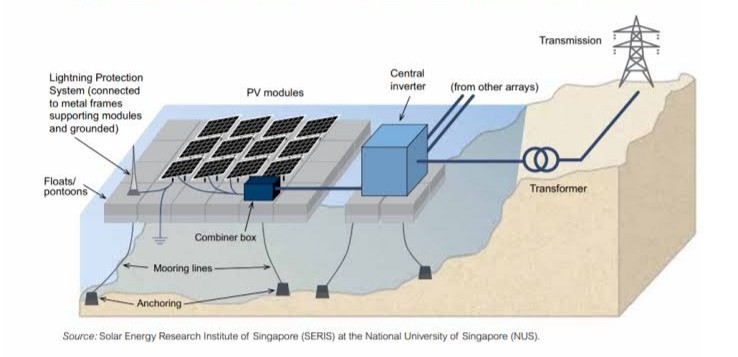
Floating solar offers an environmentally benign method of generating electricity, blending marine and renewable energy technologies. The electricity harnessed from these floating arrays is transmitted via underwater cables to a designated transmission tower.
The Key Components
- Solar Panels: These panels, identical to those used on the ground or rooftops, capture sunlight and convert it into electrical energy. We can use more efficient panels to maximize energy output within a limited space.
- Floating Platforms: Made from durable, high-density materials like HDPE (high-density polyethylene), these floating platforms ensure that the solar panels remain afloat on the water surface. Additionally, aluminium frames can be added to the floaters to enhance stability and provide a robust mounting structure for the solar panels.
- Mooring Systems: An anchoring system is employed to steadfastly secure the floating platforms, averting any drifting instigated by wind or water currents, thereby guaranteeing the stability and precise positioning of the solar arrays upon the water body. Mooring lines can be made from materials like synthetic fibre, steel wire, or chain, depending on the depth and nature of the water body.
- Inverters: The DC electricity engendered by the solar panels necessitates conversion into alternating current (AC) to facilitate utilization in electrical systems. Inverters execute this pivotal conversion, ensuring optimized electricity output for use by electric grids or on-site facilities.
- Electrical Cabling: Special waterproof cables, along with durable connectors, are used to manage the electrical connections within the system. These cables interconnect the solar panels and transmit the generated electricity to the inverters and grid connection points on land, ensuring safe and efficient energy transfer.
Advantages of Floating Solar
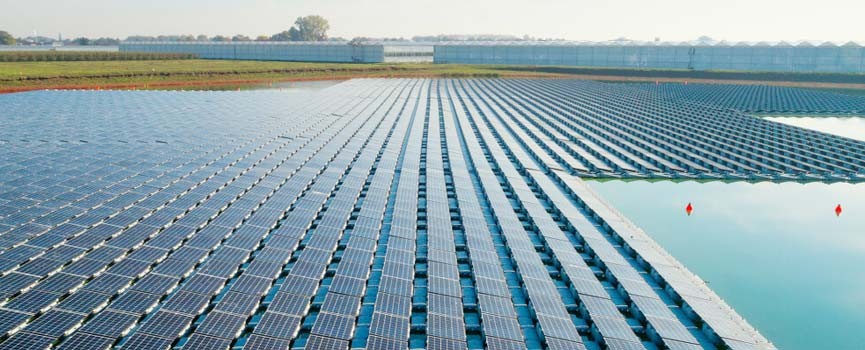
1. Space Efficiency
Floating solar panels are a testament to innovative space utilization, especially in regions where land availability is constrained or cost-prohibitive. Floating solar installations alleviate the need to repurpose fertile agricultural land or clear natural landscapes for solar farms by capitalizing on underutilized water bodies such as reservoirs, dams, and lakes. This is a significant advantage, as it allows for solar energy generation without sacrificing valuable land resources, thus promoting a harmonious co-existence with other land use priorities.
2. Enhanced Efficiency
The symbiotic relationship between water and solar panels in floating PV systems leads to enhanced solar efficiency. Water’s natural cooling effect helps to maintain lower operational temperatures for the solar panels, mitigating the common overheating issue associated with land-based solar installations. This thermoregulatory advantage can potentially boost the efficiency of solar panels by up to 15%, translating to higher energy output and, consequently, better return on investment.
3. Albedo Effect
Water bodies possess inherent reflective properties that contribute to the albedo effect, which in turn amplifies the efficiency of floating solar panels. The reflection of sunlight off the water’s surface back onto the solar panels increases the amount of photons that can be converted into electricity. This mutually beneficial interaction augments the overall energy yield, making floating solar systems an attractive proposition for optimizing solar energy generation.
4. Water Conservation
Floating solar panels contribute to water conservation by reducing evaporation from the water bodies they occupy. Particularly in arid and semi-arid regions where water scarcity is a pressing concern, the shading effect of floating solar arrays can significantly curb water evaporation, preserving vital water resources. Moreover, by inhibiting sunlight penetration, these installations help control the growth of harmful algae, thus contributing to better water quality.
5. Reduced Installation Costs
The financial requisites of floating solar installations can be less demanding compared to their land-based counterparts. They bypass the need for land acquisition and extensive site preparation, which often entail significant expenses. Furthermore, the proximity to the existing electrical infrastructure of nearby hydroelectric plants or water treatment facilities can lead to cost savings in integration and transmission infrastructure.
6. Low Impact on Aquatic Life
Preliminary studies hint at the lower impact of floating solar installations on aquatic life compared to other over-water or in-water structures. The design and positioning of floating solar panels can be managed to ensure minimal interference with aquatic habitats, thereby fostering a benign coexistence with the aquatic ecosystem.
7. Supportive Policies
Numerous nations actively promote floating solar by offering incentives for renewable energy production. These favourable policies, along with decreasing costs for floating photovoltaic systems, underpin significant industry growth projections.
8. Scalability and Flexibility
You can start small with floating solar and expand as needed. The modular nature of floating platforms makes it easy to adjust and expand the system to accommodate different site dimensions and configurations.
They also support ecological balance by mitigating algae growth in water bodies and allowing for the coexistence of aquaculture.
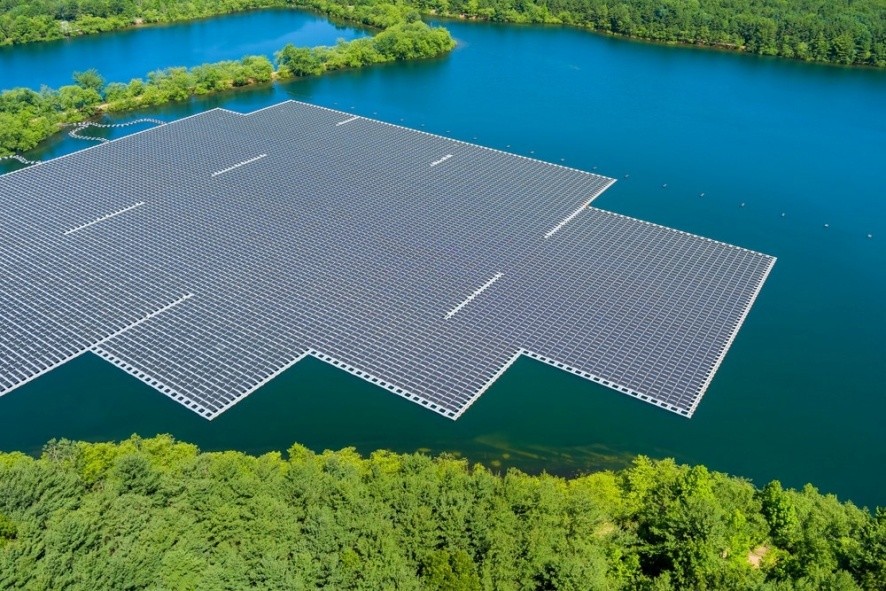
Disadvantages of Floating Solar
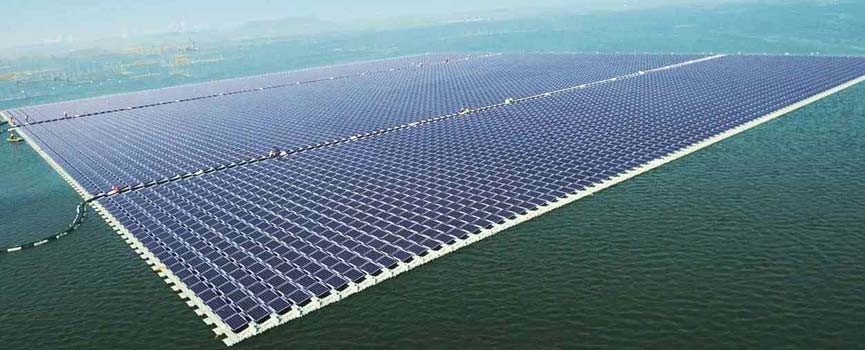
1. Increased Initial Investment
Floating solar systems, with their platforms, anchors, and cables, present more complexity and higher upfront costs compared to traditional ground-mounted systems. However, some cost analyses indicate that, over their lifespan, floating systems may incur costs comparable to, or only slightly higher than, ground systems when you factor in the efficiency improvements that can offset the initial outlay.
2. Unproven Durability
Floating solar has demonstrated reliable operation for more than ten years in pilot projects. However, their long-term durability has yet to be fully established. It is necessary to gather more data on how these systems withstand decades of exposure, including factors like weather-induced wear, performance degradation over time, and the impact of ongoing maintenance throughout their operational life.
3. Limited Application
This technology isn’t universally applicable. Many floating solar projects are large in scale and provide power to large commercial or utility companies. For individuals or entities desiring solar energy, opting for rooftop or ground-mounted solar systems is a more practical alternative.
Floating Solar Applications
In regions with plenty of open land, you might find reluctance to embrace ground-based solar projects. This hesitance stems from the fear that installing solar panels could limit the land’s use for agriculture, construction, or even preserving its natural state. Additionally, the idea of a solar farm cropping up near homes can spark disputes among local residents.
We’ll find that most floating solar farms currently occupy man-made water bodies, including reservoirs, wastewater storage ponds, and agricultural irrigation ponds. These facilities are also present in diverse settings such as quarries and mining sites, dams, and areas close to shorelines. Although natural bodies of water present opportunities for solar development, artificial reservoirs offer distinct benefits. These reservoirs generally come with pre-existing infrastructure and access roads, a result of their man-made origins, which facilitates easier and more cost-effective installationand upkeep of floating solar arrays.
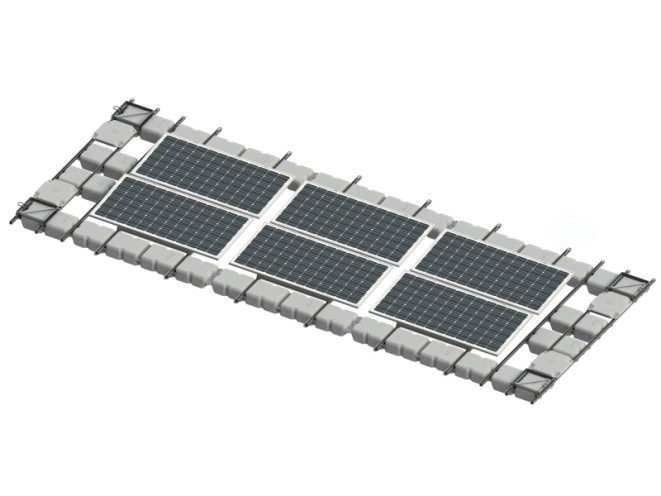

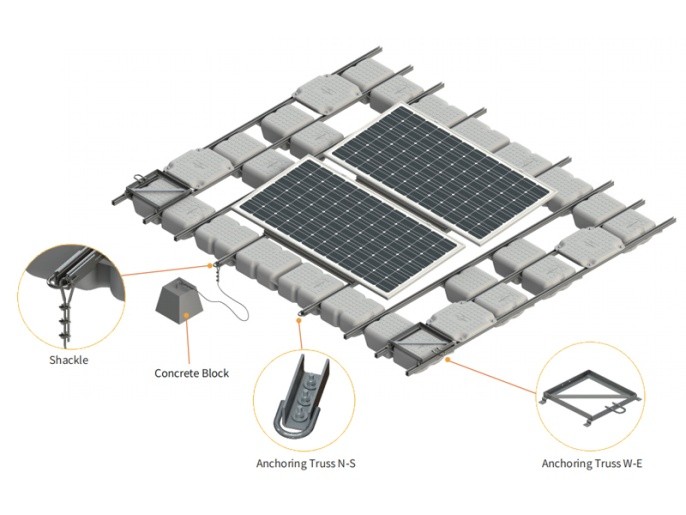
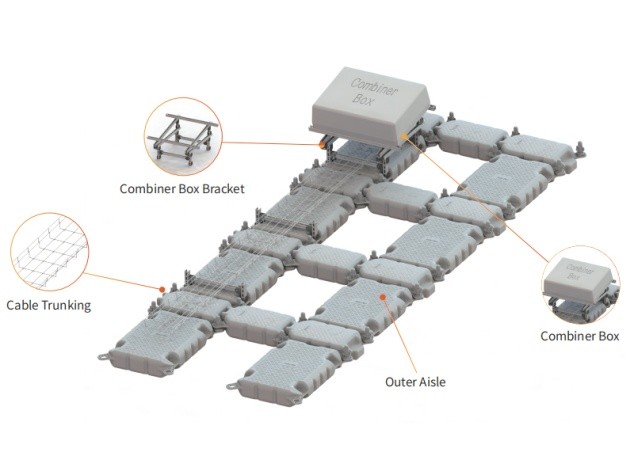

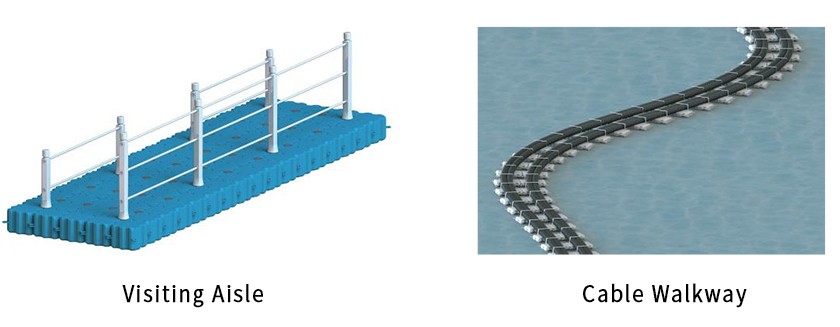
Technical Details | |
Design Description: 1. Reduce water evaporation, and utilize the cooling effect of water to increase the power generation. 2. The bracket is made of aluminium alloy for fireproof. 3. Easy to install without heavy equipment; safe and convenient to maintain. | |
Installation | Water Surface |
Surface Wave Height | ≤0.5m |
Surface Flow Rate | ≤0.5m/s |
Wind Load | ≤36m/s |
Snow Load | ≤0.45kn/m² |
Tilt Angle | 0~25° |
Standards | GB50009-2012,EN1990:2002,ASE7-05,AS/NZS1170,JIS C8955:2017 |
Material | HDPE, Anodized Aluminium AL6005-T5, Stainless Steel SUS304 |
Warranty | 10 Years Warranty |
RAMMING PILE GROUND MOUNT (SLOPE AREA)
Future Developments in Floating Solar Panels
The future of floating solar technology will be transformative in renewable energy. Companies like LESSO Solar and Masdar are pioneering advancements in efficiency and scalability, which are crucial for environmental sustainability. Their initiatives, like the expansion of Indonesia’s Cirata plant and the development of advanced technologies, exemplify the sector’s growth.
The ability of floating solar panels to adapt to different water bodies and integrate with energy grids while minimizing environmental impacts highlights their potential versatility and effectiveness. The focus on creating robust, eco-friendly, and cost-efficient floating solar solutions will intensify in upcoming years.
Collaboration among technology innovators, environmental researchers, and policymakers will be essential in harnessing the full potential of this technology. With ongoing advancements, floating solar systems are poised to significantly contribute to the global shift toward sustainable energy, playing a vital role in the renewable energy landscape.
Floating Solar will be great for Bangladesh. The design of the proposed power plant permits sufficient sunlight to enter the wetland through every two adjacent panel rows. Hence the phytoplankton and zooplankton can grow naturally and easily. The wetland of Bangladesh is very much suitable for fish cultivation due to the availability of natural food ingredients for different fish species. The power plant will not create any obstruction or hindrance to local fish habitat and other fauna. Furthermore, the power plant will provide natural sanctuary to endangered fish species and conservation of extinct fish at Chalan Beel area of Bangladesh.
Solar power arrays that float on water are becoming increasingly common in South-East Asia as the land available for the rapid expansion of renewable energy grows scarce. This floating approach may also be an option in other places where solar power’s large footprint is an issue.
According to an analysis by Jun Yee Chew at Rystad Energy, a research firm based in Norway, there are currently 500 megawatts of floating solar panels installed in South-East…

A floating solar power plant on the Cirata reservoir in Indonesia, shortly before it began operating in November 2023
FPVs have emerged as a game-changer for Southeast Asia, catalyzing the region’s push towards clean energy by maximizing its abundant solar resources and overcoming limited land availability. Their modular design allows for integration with existing hydropower dams and unlocks tremendous opportunities for hydropower-rich nations like Laos, Thailand and Indonesia. Additionally, with land rights a major deterrent facing solar developers in Southeast Asia, as much of the land is used for agriculture, FPVs provide a solution for the coexistence of solar farms and agriculture.
By maximizing this approach to land utilization, Southeast Asia can not only sidestep the intricate web of land rights issues but also promote the sustainable integration of solar energy. The success of the Thai model sets a precedent for navigating the delicate balance between agricultural needs and expanding renewable energy infrastructure and could set an example for the region at large. Additionally, with a significant portion of Southeast Asia covered by dense rainforests, FPV presents an opportunity to increase renewable energy generation without deforestation.
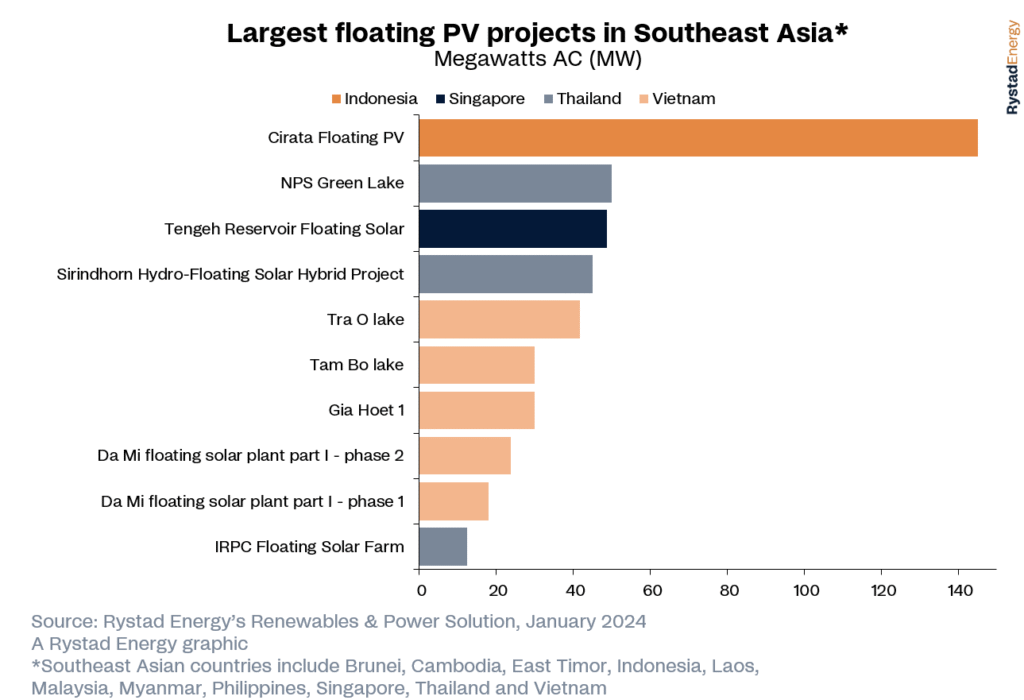
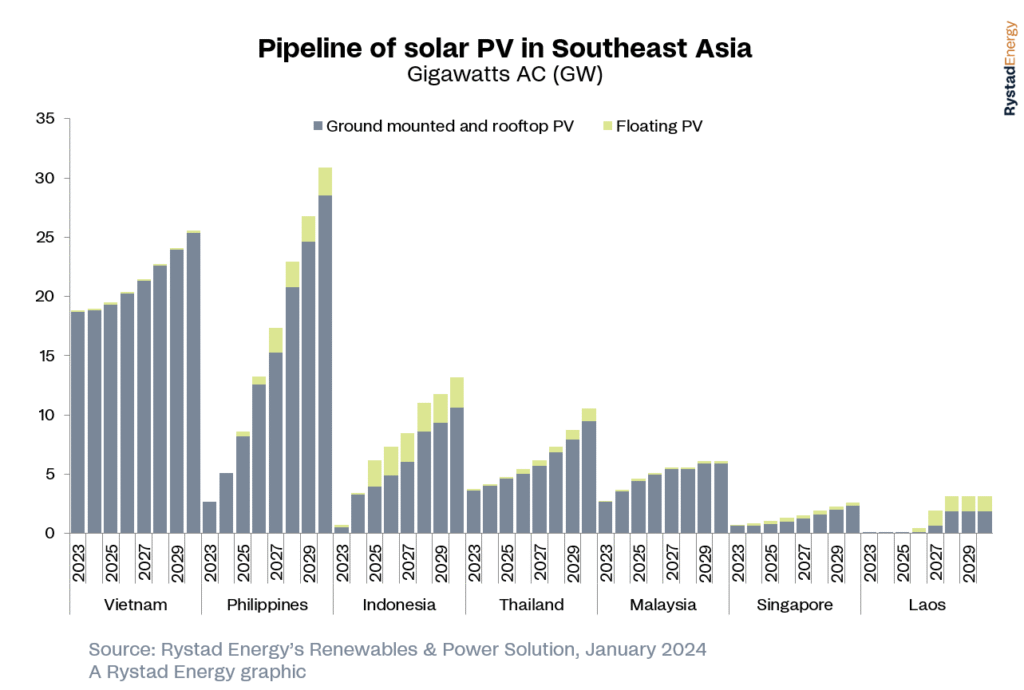
Indonesia, the Philippines and Thailand are expected to lead Southeast Asia’s push into floating solar in the years to come. As an archipelago, the Philippines has many large inland lakes that are suitable for FPV, such as Laguna Lake, where there are plans for nearly 3 gigawatts-alternating-current (GWac) of capacity.

Solar photovoltaic (PV) capacity additions are poised to be a central pillar of Southeast Asia’s energy future, with floating installations primed to play a critical role, overcoming limited land availability and presenting an opportunity to increase renewable energy generation without deforestation. Mirroring the broader Asian region’s dominance of the global floating PV (FPV) market, Rystad Energy research shows that Southeast Asia will account for 10% of the region’s total solar capacity by 2030, encompassing ground-mounted, rooftop, and FPV installations, with the Philippines, Indonesia and Thailand well-positioned to be at the forefront.
However, addressing land rights is a pivotal challenge for solar developers in Southeast Asia due to the predominant use of available land for agricultural purposes and the region grapples with a scarcity of suitable sites for solar farms, FPVs have emerged as a viable option, leveraging bodies of water adjacent to agricultural areas—an approach that circumvents land access tensions and presents a potential blueprint for other countries having similar issues.
In that case, why not Bangladesh?
Bangladesh has the golden opportunity now to have as much floatovoltaics opportunity as possible and government should take drastic action to install FPVs without a minute’s delay.
Researchers in Italy have analyzed the techno-economic viability of enhancing three pumped hydro plants in Italy with floating PV on the lower basin. They say that, with their wide results, consequences could be extrapolated to similar regions.

Scientists from Italy’s Polytechnic University of Milan (Politecnico di Milano) have conducted a techno-economic optimization for the addition of floating PV (FPV) to three existing pumped hydro storage (PHS) plants in the country.
“In this work, we have included several effects that have been overlooked in the literature, particularly the reduced evaporation rate from the water basin, the influence of the variation in temperature of the solar cells due to the presence of water, and the impact of the part-load operation of the pumps and turbines in hydroelectric plants,” corresponding author Dr. Matteo Catania told pv magazine. “By evaluating these effects, we propose a novel operating strategy for pumped hydroelectric plants, which could lead to dramatic performance improvements.”
The optimization was formulated as a mixed-integer linear programming (MILP) model, finding the best solution while using both continuous and integer variables under linear constraints.
“By applying this model to different plants, we aim to derive broader conclusions regarding the economic feasibility of integrating FPV with PHS,” the team said. “The findings obtained from our analysis hold significance beyond the specific plants studied, as they can be extrapolated to numerous hydroelectric facilities located in geographical regions sharing similar characteristics to Italy.
The three PHS plants analyzed were Bargi of Northern Italy, Capriati of the Center-South, and Taloro, located on the island of Sardinia. Based on the ratio between the maximum installable FPV and the power capacity of the smallest pump, the researchers have set an integration potential parameter (IPP) metric for each plant, reflecting its presumed practicality and efficiency. In this case, Taloro demonstrated the highest IPP, Capriati the lowest, and Bargi is placed in between.

More specifically, Taloro has a pumping capacity of 280 MW, an upstream basin volume of 60.50 Mm³, a downstream basin volume of 18.80 Mm³, a downstream basin surface of 0.82 km², and an average yearly irradiance of 182.83 W/m². Capriati has a pumping capacity of 113 MW, an upstream basin volume of 8.55 Mm³, a downstream basin volume of 4.80 Mm³, a downstream basin surface of 0.11 km², and an average yearly irradiance of 178.60 W/m². Bargi has a pumping capacity of 330 MW, an upstream basin volume of 6.28 Mm³, a downstream basin volume of 43.85 Mm³, a downstream basin surface of 1.50 km², and an average yearly irradiance of 156.29 W/m².
With those parameters, among others, as inputs, the MILP algorithm runs on the Pyomo software. As an output, the model has then provided the preliminary plant operation results as well as the optimal FPV capacity. In all cases, the FPV was only installed on the lower basin using 440 W panels with an efficiency of 20.39%.[1]
I can’t stress more how important and crucial FPVs are for Bangladesh.
[1]PV Magazine: The case for combining pumped-hydro storage with floating PV; January 23, 2025.